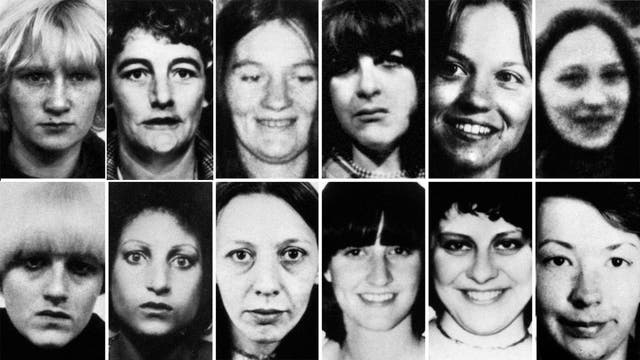
The hunt for the Yorkshire Ripper was the biggest manhunt Britain had ever known and the analysis of its many failings changed the way police mount major investigations.
Despite the 2.5 million police officer hours expended on catching him, Peter Sutcliffe continued his murderous spree for more than five years as the inquiry made a series of spectacular blunders.
At his Old Bailey trial, Sutcliffe himself said: “It was just a miracle they did not apprehend me earlier – they had all the facts.”
He was interviewed nine times, but was only caught when picked up by chance with a prostitute in his car.
One of the main reasons Sutcliffe was overlooked, despite the protestations of junior officers, was because Assistant Chief Constable George Oldfield, in overall command of the hunt, was hoodwinked by a hoax tape and two letters sent from Sunderland, which purported to be from the Ripper.
There were warnings of a hoax from voice experts and other detectives, but Oldfield pressed on, convinced this was his man.
Because the voice on the tape had a North East accent, Sutcliffe, who was from Bradford, was not in the frame.
Oldfield’s mistake has been described as one of the biggest in British criminal history.
When the tape arrived it was a personal message to Oldfield, which said: “Lord, you are no nearer catching me now than four years ago when I started.
“I reckon your boys are letting you down George. You can’t be much good can ya?”
Later the same year Oldfield had a heart attack at the age of 57, and was subsequently moved off the case.
With attention focused on suspects with a North East accent, the Ripper continued his killing spree and claimed his 13th and last murder victim, 21-year-old student Jacqueline Hill, late in 1980.
Sunderland man John Humble admitted to being Wearside Jack in 2006 and was jailed for eight years for perverting the course of justice.

The 200-strong Ripper squad eventually carried out more than 130,000 interviews, visited more than 23,000 homes and checked 150,000 cars.
The Ripper incident room at Millgarth police station used a card index system which was overwhelmed with information and not properly cross-referenced, leading to evidence against Sutcliffe getting lost in the system.
Crucial similarities between him and the suspect, like the gap in his teeth and his size seven feet, were not picked up.
As early as 1976, when Marcella Claxton was hit over the head with a hammer near her home in Leeds, potentially vital evidence was overlooked.
She survived the attack and was able to help police produce a photofit, which later proved to be accurate, but she was discounted as a Ripper victim because she was not a prostitute.
On one occasion Sutcliffe was interviewed by officers who showed him a picture of the Ripper’s bootprint near a body, they failed to notice that Sutcliffe was wearing the exact same pair of boots.
Police also overlooked Sutcliffe’s arrest in 1969 for carrying a hammer in a red light district, and attempts by his friend Trevor Birdsall to point the finger at him in an anonymous letter.

Then, in January 1981, police finally got some luck when Sutcliffe was arrested by officers in Sheffield, who stopped him with a prostitute in his brown Rover car.
The car had false number plates and Sutcliffe’s name was passed on to the Ripper squad, where it came up on their index cards.
Officers later found screwdrivers in his car.
A hammer and knife was found 50ft from where his car had been after officers allowed him to go to the toilet at the side of a building.
Later, Sutcliffe calmly told Detective Inspector John Boyle, who was interviewing him: “It’s all right, I know what you’re leading up to. The Yorkshire Ripper. It’s me. I killed all those women.”
He then began a detailed confession lasting 24 hours, and asked for his wife, Sonia, to be brought in so he could tell her personally that he was the Ripper.

A series of inquiries into the police investigation have shaped the way in which all major inquiries are now conducted.
West Yorkshire Police constable John Robins said on Friday: “The investigation into offences committed by Peter Sutcliffe was, at the time, the largest ever conducted by a UK police force and was subject to two exhaustive reviews in the immediate aftermath.
“The 1981 report by Sir Lawrence Byford and a subsequent review conducted by former West Yorkshire Police Chief Constable Colin Sampson identified the extensive efforts made by the inquiry team, as well as what clearly went wrong.
“Failings and mistakes that were made are fully acknowledged and documented.
“We can say without doubt that the lessons learned from the Peter Sutcliffe inquiry have proved formative in shaping the investigation of serious and complex crime within modern day policing.
“West Yorkshire Police is committed to ensuring that those harmed by crime are at the heart of what we do.”


Comments: Our rules
We want our comments to be a lively and valuable part of our community - a place where readers can debate and engage with the most important local issues. The ability to comment on our stories is a privilege, not a right, however, and that privilege may be withdrawn if it is abused or misused.
Please report any comments that break our rules.
Read the rules here